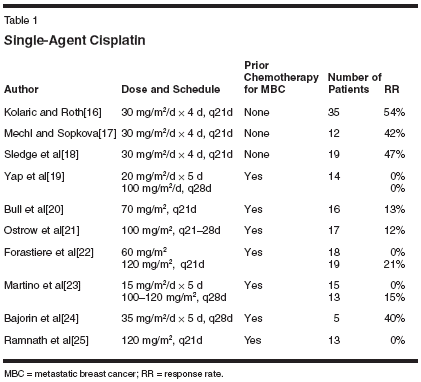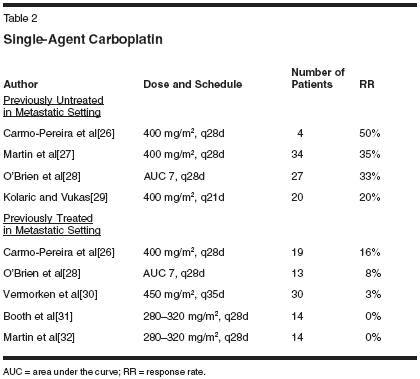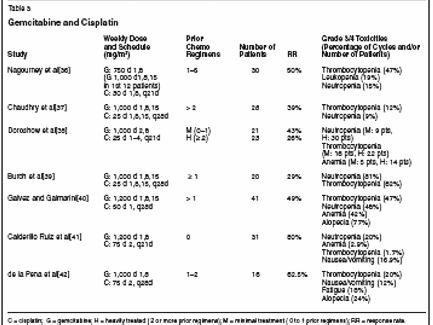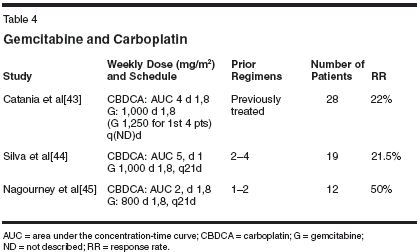Gemcitabine and Platinum-Based Chemotherapy in Metastatic Breast Cancer
Although anthracyclines and the taxanes comprise the most activefirst-line cytotoxic treatments in patients with hormone-insensitive orlife-threatening metastatic breast cancer, many patients progress andrequire other chemotherapeutic agents. Development of new combinationsand/or agents is thus needed. Gemcitabine (Gemzar) and platinumcompounds have been employed as single agents, and the additionof gemcitabine to the platinums results in significant clinical benefitand response rates. Correlative biologic studies are expected fromseveral already-reported trials and may help elucidate predictive factorsfor both response and toxicity when combining gemcitabine andthe platinums. Trials incorporating these doublets in earlier stages ofbreast cancer or in the neoadjuvant setting may further elucidate theirrole in breast cancer treatment.
Although anthracyclines and the taxanes comprise the most active first-line cytotoxic treatments in patients with hormone-insensitive or life-threatening metastatic breast cancer, many patients progress and require other chemotherapeutic agents. Development of new combinations and/or agents is thus needed. Gemcitabine (Gemzar) and platinum compounds have been employed as single agents, and the addition of gemcitabine to the platinums results in significant clinical benefit and response rates. Correlative biologic studies are expected from several already-reported trials and may help elucidate predictive factors for both response and toxicity when combining gemcitabine and the platinums. Trials incorporating these doublets in earlier stages of breast cancer or in the neoadjuvant setting may further elucidate their role in breast cancer treatment.
It is estimated that 40,580 patients will die of breast cancer in the United States this year.[1] Cytotoxic chemotherapy is used in patients with hormone-insensitive or lifethreatening metastatic breast cancer.[ 2] Although anthracyclines and the taxanes are the most active firstline treatments, many patients will progress and require other chemotherapeutic agents. New regimens are continuously being sought. Gemcitabine (Gemzar) and platinum compounds have been used as single agents, but there is little experience with the two in combination. This review summarizes the experience of combining these two classes of chemotherapeutic drugs. Gemcitabine Gemcitabine (2',2'-difluorodeoxycytidine, dFdC) is a difluorinated analog of deoxycytidine and thus is a nucleoside analog or an antimetabolite. After it enters cells, intracellular phosphorylation by nucleoside monophosphate and diphosphate kinases produces 5'-diphosphate (dFdCDP) and 5'-triphosphate (dFdCTP) derivatives, respectively.[3,4] Diphosphate nucleotide inhibits ribonucleotide reductase, an enzyme essential for intracellular synthesis of deoxynucleotide triphosphates (including dCTP) for DNA synthesis. Gemcitabine triphosphate acts as a fraudulent base, competing with dCTP for incorporation into DNA. If incorporated into DNA, only one more nucleotide can be incorporated before DNA chain elongation is halted. DNA polymerase epsilon is then unable to remove the gemcitabine nucleotide and repair the growing DNA strands (masked chain termination). Gemcitabine possesses a much wider clinical spectrum of activity than does cytarabine (Ara-C), despite their similarities in structure, metabolism, and mechanisms of action.[5] Antitumor activity of gemcitabine has been demonstrated against cancers of the pancreas, small-cell and non-smallcell lung cancer, and bladder cancer. There have been eight phase II trials investigating the role of gemcitabine as a single agent in the treatment of metastatic breast cancer.[6-13] Collectively, these trials involved 237 patients and used gemcitabine as first-, second-, and third-line treatments. Most patients had received prior treatment with anthracyclines and the taxanes. Response rates vary from 13% to 42%, and median survival varies from 11.5 to 18.6 months. The main toxicities (grade 3/4) were neutropenia, thrombocytopenia, nausea, and vomiting. These data suggested that gemcitabine has activity in metastatic breast cancer and possesses an acceptable toxicity profile. Cisplatin Cisplatin (cis-diamminedichloroplatinum) is an alkylating agent that reacts preferentially at the N7 position of guanine and adenine residues to form monofunctional and bifunctional adducts.[14] The monoadducts may then form intra- or interstrand DNA cross-links that ultimately lead to apoptosis.[15] Side effects include acute or delayed nausea and vomiting, cisplatin-induced nephrotoxicity, urinary loss of potassium and magnesium, and neurotoxicity (peripheral neuropathy, tinnitus, high-frequency hearing loss, and Lhermitte's sign). There have been three studies reported on the use of cisplatin as a single agent in the first-line treatment of metastatic breast cancer. These studies involved a total of 66 patients and demonstrated a response rate of 50%. In patients who have received prior chemotherapy, the response rate to single-agent cisplatin ranges from 0% to 40% (Table 1).[16-25]

Carboplatin Carboplatin (Paraplatin) is an analog of cisplatin developed in the late 1970s by investigators searching for a compound possessing the antitumor activities but not the toxicities of cisplatin. Carboplatin is more stable because the platinum is part of a six-member ring. It causes less nausea and vomiting, nephrotoxicity, neurotoxicity, and ototoxicity but more myelosuppression and thrombocytopenia. Four phase II trials have been reported in women with no exposure to chemotherapy in the metastatic setting, and five phase II trials have been reported in women who have received prior chemotherapy for metastatic breast cancer (Table 2).[26-32] Of the 85 women who received first-line carboplatin, 27 responded, for a 32% response rate. Comparatively, only 5 of 90 women who had received prior chemotherapy responded, for a 6% response rate.

Oxaliplatin Oxaliplatin (Eloxatin) is an antineoplastic platinum derivative with a 1,2-diaminocyclohexane carrier ligand. Although its precise mechanism of action is unknown, it is thought to act similarly to other platinum derivatives. Platinum derivatives exert their effect through the formation of DNA adducts that block DNA replication and transcription, resulting in cell death of actively dividing cells as well as inducing apoptosis. Oxaliplatin is more potent than cisplatin in vitro, requiring fewer DNA adducts to achieve an equal level of cytotoxicity. Evidence of response in two separate oxaliplatin phase I trials in women with metastatic breast cancer led to a phase II trial by Garufi et al of single-agent oxaliplatin (130 mg/m2 on day 1, every 3 weeks) in previously treated women with metastatic breast cancer. Despite the poor prognostic factors, 21% of the 14 anthracycline- pretreated, advanced breast cancer patients entered onto the trial achieved a response (lasting 2 to 5 months). Median survival was 12 months.[33] Gemcitabine and a Platinum Both human tumor cultures and breast cancer cell lines have demonstrated in vitro synergy between gemcitabine and cisplatin.[34] As stated previously, the platinum compounds form DNA adducts.[14,35] The DNA adducts may then form intrastrand or interstrand DNA cross-links that ultimately lead to apoptosis. With DNA platination, there is subsequent recruitment of DNA repair complexes, as well as an increased requirement of deoxynucleosides (dCTP, dATP, dGTP, and dTTP). Gemcitabine inhibits ribonucleotide reductase responsible for catalyzing the reactions that generate the deoxynucleotide triphosphates for DNA synthesis, causing a reduction in the concentrations of the deoxynucleotides. In addition, following phosphorylation, gemcitabine is converted to a triphosphate form that is incorporated into DNA and interferes with DNA synthesis. Thus, with this putative mechanism of interaction, it is not surprising that preclinical studies have shown synergy with the combinations of gemcitabine and both cisplatin and oxaliplatin.

There have been seven phase II trials evaluating the combination of gemcitabine and cisplatin in a total of 210 patients (Table 3).[36-42] Most trials included patients who had received prior chemotherapy. Response rates varied from 26% to 80%. The most common toxicities were neutropenia, thrombocytopenia, anemia, and nausea/vomiting. Nagourney et al[36] published a study on the use of gemcitabine plus cisplatin in relapsed breast cancer. Cisplatin (30 mg/m2) and gemcitabine (1,000 mg/m2) were given on days 1, 8, and 15 of a 28-day cycle. Because of significant toxicity, the regimen was modified after the 12th patient to cisplatin (30 mg/m2) and gemcitabine (750 mg/m2) on days 1 and 8 of a 21- day cycle. This regimen was developed based on this group's prior observations and mechanistic analyses, which indicated that simultaneous or close sequencing of gemcitabine and cisplatin enhanced the synergistic interaction of these two drugs. Of 30 patients, 3 (10%) had a complete response and 12 patients (40%) had a partial response, for an overall response rate of 50%. Of note, two of the responses were seen among the four women who had previously been treated with high-dose/stem cell therapy. The median time to disease progression was 14 weeks for all 30 patients but 23.5 weeks for the patients who had an objective response. The main grade 3/4 toxicities were hematologic: thrombocytopenia in 33%/14% and neutropenia in 11%/ 4%, respectively. Chaudhry and colleagues[37] studied 28 patients for whom prior treatment with anthracyclines and taxanes failed. Women received cisplatin (25 mg/m2) and gemcitabine (1,000 mg/ m2) on days 1, 8, and 15 of a 28-day cycle. One patient (3.6%) had a complete response and 10 patients (35.7%) had a partial response, for a total response rate of 39%. The median duration of response was 21 weeks (range: 14 to 65 weeks). The most common side effects (grade 4) were thrombocytopenia in 12% and neutropenia in 9% of patients. Doroshow and co-workers[38] conducted a phase II study with 55 patients who were divided into those who had zero to one prior regimens (minimally treated group or "M") and those with two or more prior regimens, including doxorubicin or a taxane (heavily treated group or "H"). Cisplatin (25 mg/m2) was given on four sequential days (days 1-4) and gemcitabine (1,000 mg/m2) was given on days 2 and 8 during a 21-day cycle. Granulocyte colony-stimulating factor was given to the heavily pretreated group. In the minimally treated group, two patients had a complete response and seven patients had a partial response, for a response rate of 43%. In the heavily pretreated group, two patients experienced a CR and four patients had a partial response, for a response rate of 26%. The main grade 3/4 toxicities were, again, hematologic; 39 patients developed neutropenia, 38 patients had thrombocytopenia, and 19 patients developed anemia. Burch and the North Central Cancer Treatment Group (NCCTG) [39] performed a phase II study with 20 patients who had received at least one prior anthracycline or taxane-containing chemotherapy regimen either as adjuvant therapy for breast cancer or in the metastatic setting. A two-stage design was used with 20 patients enrolled in the first phase. If more than three responses were seen, a second phase of 30 patients was to be conducted. This report considers the patients entered into the first phase of the trial. Patients received cisplatin (25 mg/m2) and gemcitabine (1,000 mg/m2) on days 1, 8, and 15 of a 28- day cycle. Of 20 patients, 1 had a CR and 5 experienced a PR, for a RR of 29% and a time to disease progression of 7.1 months. Toxicities included neutropenia (38% grade 3, 43% grade 4) and thrombocytopenia (24% grade 3, 38% grade 4). Because of the significant hematologic activity, patients on the second phase of the trial received 800 mg/m2 of gemcitabine and 25 mg/m2 of cisplatin. Galvez and Galmarini[40] reported on 41 women with metastatic breast cancer who had progressed after previous anthracycline therapy. Cisplatin (50 mg/m2) was given on day 1, and gemcitabine (1,200 mg/m2) was delivered on days 1, 8, and 15 of a 28- day cycle. Four women (10%) had a CR and 16 women (39%) had a PR, for an overall RR of 49% and a time to disease progression of 5.2 months. The main grade 3/4 toxicities were hematologic; thrombocytopenia (47%), neutropenia (48%), and anemia (42%) resulted in red cell and platelet transfusion in 35% and 10% of patients, respectively. Calderillo Ruiz and associates[41] evaluated the response to gemcitabine and cisplatin as first-line therapy in 31 patients. Cisplatin (75 mg/m2) was administered on day 2, and gemcitabine (1,200 mg/m2) was given on days 1 and 8 of a 21-day cycle. Four patients had a CR and 21 patients had a PR, for an overall RR of 80%. Grade 3/4 toxicities included neutropenia in 20%, anemia in 2.9%, thrombocytopenia 1.72%, and nausea/vomiting in 16.9% of cycles. de la Pena and collaborators [42] reported their study of 16 patients who had received one to two previous chemotherapy regimens. Cisplatin (75 mg/m2) was given on day 2, and gemcitabine (1,000 mg/m2) was given on days 1 and 8 of a 28-day cycle. Four (25%) patients had a CR and six patients (37.5%) had a PR, for an objective response rate of 62.5%. The median time to disease progression was 11.2 months. Grade 3/4 toxicities included thrombocytopenia in 19.5%, fatigue in 18%, and nausea/vomiting in 12.1%. These seven studies suggest that the synergism observed in vitro with the combination of cisplatin and gemcitabine is borne out by the response rates in this group of previously treated and untreated women with metastatic breast cancer. Without comparison, however, the optimal regimen with the greatest response rate and the least toxicity has yet to be elucidated. Gemcitabine Plus Carboplatin The combination of gemcitabine and carboplatin has also been found to have synergy in vitro. Three trials have recently been reported using this combination in women with metastatic breast cancer (Table 4).

Catania et al[43] reported a study of 28 women with metastatic breast cancer. All women had received prior chemotherapy for metastatic breast cancer. Of the 28 patients, 21 had received ≥ 3 prior regimens. Carboplatin at an area under the concentration- time curve [AUC] of 4 (Calvert's formula) and gemcitabine at 1,250 mg/m2 were delivered on days 1 and 8. (The cycle length was not described.) After the first four patients, the gemcitabine dose was reduced to 1,000 mg/m2. There were no complete responses, but 5 of 23 evaluable women (22%) had a partial response. Grade 3/4 toxicities after the gemcitabine dose reduction included thrombocytopenia (21%) and neutropenia (50%) with one episode of febrile neutropenia. Silva and colleagues[44] reported on 19 patients who were heavily pretreated with between two and four cycles of prior chemotherapy for metastatic breast cancer. Carboplatin at an AUC of 5 was given on day 1, and gemcitabine at 1,000 mg/m2 was given on days 1 and 8 every 21 days. A complete response was seen in two patients and a partial response was seen in another two patients, for an overall response rate of 21.5%. Grade 3/4 hematologic toxicity was minimal (< 6%). Nagourney et al[45] reported on 12 women in first or second relapse with metastatic breast cancer with no known brain metastases. Two of these women were subsequently excluded for brain metastases detected at cycle 1. Carboplatin at an AUC of 2 and gemcitabine (800 mg/m2) were both given on days 1 and 8 of a 21-day cycle. One complete (10%) and four partial (40%) responses were seen in the 10 evaluable patients. The median time to disease progression was 5 months. Grade 3/4 hematologic toxicities included neutropenia (60%), thrombocytopenia (40%), and anemia (20%). Further information is forthcoming from these and other studies with this doublet combination of carboplatin and gemcitabine. Gemcitabine Plus Oxaliplatin No phase II trials have yet been reported with this combination in women with metastatic breast cancer. However, they are ongoing, based on the in vitro synergy between these two drugs and the response rates seen with other malignancies. Conclusion Despite the finding that the platinums have relatively low response rates in pretreated women with metastatic breast cancer, the addition of gemcitabine to the platinums results in significant clinical benefit and response rates. Correlative biologic studies are pending from several of the previously reported trials and may help elucidate predictive factors for both response and toxicity when combining gemcitabine and the platinums. Further trials incorporating these doublets in earlier stages of breast cancer or in the neoadjuvant setting are warranted.
Disclosures:
Dr. Russell has received grant support from Lilly Oncology.
References:
1. Jemal A, Tiwari RC, Murray T, et al: Cancer statistics, 2004. CA Cancer J Clin 54:8-29, 2004.
2. Hortobagyi GN: Treatment of breast cancer. N Engl J Med 339:974-984, 1998.
3. Heinemann V, Hertel LW, Grindey GB, et al: Comparison of the cellular pharmacokinetics and toxicity of 2',2'-difluorodeoxycytidine and 1-β-D-arabinofuranosylcytosine. Cancer Res 48:4024-4031, 1988.
4. Heinemann V, Xu Y-Z, Chubb S, et al: Cellular elimination of 2',2'-difluorodeoxycytidine 5'-triphosphate: A mechanism of selfpotentiation. Cancer Res 52:533-539, 1992.
5. Plunkett W, Huang P, Searcy CE, et al: Gemcitabine: Preclinical pharmacology and mechanisms of action. Semin Oncol 23(suppl 10):3-15, 1996.
6. Blackstein M, Vogel CL, Ambinder R, et al: Gemcitabine as first-line therapy in patients with metastatic breast cancer: A phase II trial. Oncology 62:2-8, 2002.
7. Carmichael J, Possinger K, Phillip P, et al: Advanced breast cancer: A phase II trial with gemcitabine. J Clin Oncol 13:2731-2736, 1995.
8. Possinger K, Kaufmann M, Coleman R, et al: Phase II study of gemcitabine as firstline chemotherapy in patients with advanced or metastatic breast cancer. Anticancer Drugs 10:155-162, 1999.
9. Gerson R, Senaro A, Villabbos A, et al: Gemcitabine response in advanced breast cancer in relation to immunohistochemical factors (abstract 572). Proc Am Soc Clin Oncol 19:145a, 2000.
10. Valerio M, Cicero G, Armata M: Gemcitabine (G) in pretreated breast cancer (BC) (abstract 1953). Proc Am Soc Clin Oncol 20:51b, 2001.
11. Brodowicz T, Koestler WJ, Tomek S, et al: Monotherapy with docetaxel in second- or third-line treatment of anthracycline-resistant metastatic breast cancer. Anticancer Drugs 11:149-153, 2000.
12. Spielmann M, Llombart-Cussac A, Kalla S, et al: Single-agent gemcitabine is active in previously treated metastatic breast cancer (MBC). Oncology 60:303-307, 2001.
13. Schmid P, Akrivakis K, Flath B, et al: Phase II trial of gemcitabine as prolonged infusion in metastatic breast cancer. Anticancer Drugs 10:625-631, 1999.
14. Eastman A: The formation, isolation and characterization of DNA adducts produced by anticancer platinum complexes. Pharmacol Ther 34:155-166, 1987.
15. Sorenson C, Barry M, Eastman A: Analysis of events associated with cell cycle arrest at G2 phase and cell death induced by cisplatin. J Natl Cancer Inst 82:749-755, 1990.
16. Kolaric K, Roth A: Phase II clinical trial of cis-dichlorodiammine platinum (cis-DDP) for antitumorigenic activity in previously untreated patients with metastatic breast cancer. Cancer Chemother Pharmacol 11:108-112, 1983.
17. Mechl Z, Sopkova B: CAP (cyclophosphamide, Adriamycin, cisplatinum) in the treatment of advanced breast cancer. Neoplasma 31:431-435, 1984.
18. Sledge GW Jr, Loehrer PJ Sr, Roth BJ, et al: Cisplatin as first-line therapy for metastatic breast cancer. J Clin Oncol 6:1811-1814, 1988.
19. Yap HY, Salem P, Hortobagyi GN, et al: Phase II study of cis-dichlorodiammineplatinum (II) in advanced breast cancer. Cancer Treat Rep 62:405-408, 1978.
20. Bull JM, Anderson T, Lippman ME, et al: A phase II trial of cis-dichlorodiammine platinum II (CIC-DDP) in breast and ovarian carcinomas (abstract 345). Proc Am Soc Clin Oncol 19:87, 1978.
21. Ostrow S, Egorin M, Aisner J, et al: Highdose cis-diamminedichloro-platinum therapy in patients with advanced breast cancer: Pharmacokinetics, toxicity, and therapeutic efficacy. Cancer Clin Trials 3:23-27, 1980.
22. Forastiere AA, Hakes TB, Wittes JT, et al: Cisplatin in the treatment of metastatic breast carcinoma: A prospective randomized trial of two dosage schedules. Am J Clin Oncol 5:243-247, 1982.
23. Martino S, Samal BA, Singhakowinta A, et al: A phase II study of cisdiamminedichloroplatinum II for advanced breast cancer: Two dose schedules. J Cancer Res Clin Oncol 108:354-356, 1984.
24. Bajorin D, Bosl GJ, Fein R: Phase I trial of escalating doses of cisplatin in hypertonic saline. J Clin Oncol 5:1589-1593, 1987.
25. Ramnath N, LoRusso P, Simon M, et al: Phase II evaluation of cisplatin and WR2721 for refractory metastatic breast cancer. Am J Clin Oncol 20:368-372, 1997.
26. Carmo-Pereira J, Olivera-Costa F, Henriquez E, et al: Carboplatin as primary chemotherapy for disseminated breast carcinoma: A phase II study (abstract P0971). Presented at the 5th European Conference on Clinical Oncology; 1989; London.
27. Martin M, Diaz-Rubio E, Casado A, et al: Carboplatin: An active drug in metastatic breast cancer. J Clin Oncol 10:433-437, 1992.
28. O'Brien ME, Talbot DC, Smith IE: Carboplatin in the treatment of advanced breast cancer: A phase II study using a pharmacokinetically guided dose schedule. J Clin Oncol 11:2112-2127, 1993.
29. Kolaric K, Vukas D: Carboplatin activity in untreated metastatic breast cancer patients- Results of a phase II study. Cancer Chemother Pharmacol 27:409-412, 1991.
30. Vermorken JB, Gundersen S, Clavel M, et al: Randomized phase II trial of iproplatin and carboplatin in advanced breast cancer. The EORTC Early Clinical Trials Group and the EORTC Data Center. Ann Oncol 4:303-306, 1993.
31. Booth BW, Weiss RB, Korzun AH, et al: Phase II trial of carboplatin in advanced breast carcinoma. A Cancer and Leukemia Group B Study. Cancer Treat Rep 69:919-920, 1985.
32. Martin M, Diaz-Rubio E, Casado A, et al: Phase II study of carboplatin in advanced breast cancer: Preliminary results. Semin Oncol 18(1 suppl 2):23-27, 1991.
33. Garufi C, Nistico C, Brienza S, et al: Single-agent oxaliplatin in pretreated advanced breast cancer patients: A phase II study. Ann Oncol 12:179-182, 2001.
34. Peters GHQ, Bergman AM, Ruin van Haperen VWT: Interaction between cisplatin and gemcitabine in vitro and in vivo. Semin Oncol 22(suppl 1):72-79, 1995.
35. Jennerwein MM, Eastman A, Khokhar A: Characterization of adducts produced in DNA by isomeric 1,2-diaminocyclohexaneplatinum (II) complexes. Chem Biol Interact 70:39-49, 1989.
36. Nagourney RA, Link JS, Blitzer JB, et al: Gemcitabine plus cisplatin repeating doublet therapy in previously treated, relapsed breast cancer patients. J Clin Oncol 18:2245- 2249, 2000.
37. Chaudhry S, Abdel-Rahman HA, Patil R, et al: Prospective phase II study of weekly cisplatin-gemcitabine in refractory metastatic breast cancer (RM-BC) (abstract 430). Proc Am Soc Clin Oncol 19:111a, 2000.
38. Doroshow JH, Tetef M, Margolin K: Significant activity of gemcitabine (Gem) and cisplatin (DDP) in both heavily (H) and minimally (M) pretreated breast cancer (MBC) patients. A California Cancer Consortium/Loyola University of Chicago trial (abstract 609H). Proc Am Soc Clin Oncol 19:155a, 2000.
39. Burch PA, Mailiard JA, Hillman DW, et al: Phase II study of gemcitabine and cisplatin in patients with metastatic breast cancer (MBC) and failure on prior chemotherapy. A North Central Cancer Treatment Group trial (abstract 322). Breast Cancer Res Treat 64:81, 2000.
40. Galvez CA, Galmarini F: Monthly cisplatin and gemcitabine as second line chemotherapy for patients with advanced breast cancer (abstract 324). Breast Cancer Res Treat 64:81, 2000.
41. Calderillo Ruiz GC, Pena HF, Meza FA, et al: A phase II study of gemcitabine plus cisplatin in metastatic breast cancer (MBC) (abstract 1988). Proc Am Soc Clin Oncol 20: 2001.
42. de la Pena HF, Tellez E, Bastarrachea J, et al: Gemcitabine plus cisplatin as a palliative treatment in metastatic or refractory breast cancer (MRBC) (abstract 1990). Proc Am Soc Clin Oncol 20:2001.
43. Catania C, Nole F, Balduzzi A, et al: Caring for heavily pretreated patients with metastatic breast cancer (MBC): Carboplatin (CBDCA) - gemcitabine (GCB) combination is effective and well tolerated (abstract 724). Proc Am Soc Clin Oncol 23:57, 2004.
44. Silva JA, Perez Michel LM, Gallardo Rincon D, et al: Gemcitabine plus carboplatin in recurrent and advanced breast cancer: A phase II trial (abstract 877). Proc Am Soc Clin Oncol 23:95, 2004.
45. Nagourney RA, Link J, Sommers W, et al: Carboplatin and gemcitabine repeating doublet in recurrent breast cancer (abstract 851). Proc Am Soc Clin Oncol 23:88, 2004.
Gedatolisib Combo With/Without Palbociclib May Be New SOC in PIK3CA Wild-Type Breast Cancer
December 21st 2025“VIKTORIA-1 is the first study to demonstrate a statistically significant and clinically meaningful improvement in PFS with PAM inhibition in patients with PIK3CA wild-type disease, all of whom received prior CDK4/6 inhibition,” said Barbara Pistilli, MD.